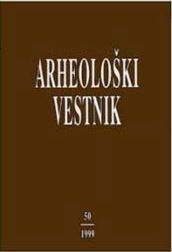The Alcestis Sarcophagus and the Orestes Sarcophagus in the Vatican and Reliefs in Šempeter
Abstract
The sarcophagus illustrating the story of Alcestis, at the Vatican in the Museo Shiaramonti, inv. no. 1195, and the sarcophagus illustrating the story of Orestes, at the Vatican in the Museo Gregoriano Profano, inv. no. 10450, were discovered already during the first decades of the previous century; their attributed chronological dates are indisputable. The Alcestes sarcophagus dates by the inscription to between the years 160-170 AD, while the Orestes sarcophagus dates approximately to the time that Hadrian's brother-in-law, L. Iulius Ursus Servianus, was the third time consul (134 AD). The styles of the reliefs correspond in both instances to the artistic style of Roman sculptures during these periods. Select details of the scenes portrayed on the reliefs have yet to be adequately clarified. It is highly significant that the Alcestes story is according to Euripides' drama, Alkestes, while the Orestes story on the frontal panel of the sarcophagus is according to Aeschylus' drama, Hoeforoi, and on the frontal panel of the cover according to Euripides' drama, Iphigeneia in Tauris. Despite that the Orestes sarcophagus is an integrate monumental work, the reliefs on the sarcophagus coffer and cover are the work of two artists. The scenes on both sarcophagi present interpretations of old myths according to Neopythagorean symbolism of life beyond the grave.
The reliefs on the tombs in Šempeter near Celje portray, in the style of Norican-Pannonian artistry of the 2nd century AD, a reflection of the great Roman artistry in Mediterranean centers in the eastern part of the empire, as well as in Rome; the motifs are copied from Euripides and the symbolic message of the sculptures is also entirely analogous to the symbolism on the sarcophagi in the Vatican.
Downloads
References
.
Downloads
Published
How to Cite
Issue
Section
License

This work is licensed under a Creative Commons Attribution-NonCommercial-NoDerivatives 4.0 International License.
Authors guarantee that the work is their own original creation and does not infringe any statutory or common-law copyright or any proprietary right of any third party. In case of claims by third parties, authors commit their self to defend the interests of the publisher, and shall cover any potential costs.
More in: Submission chapter





